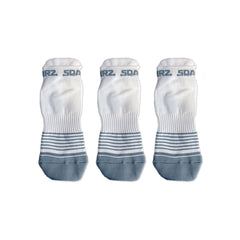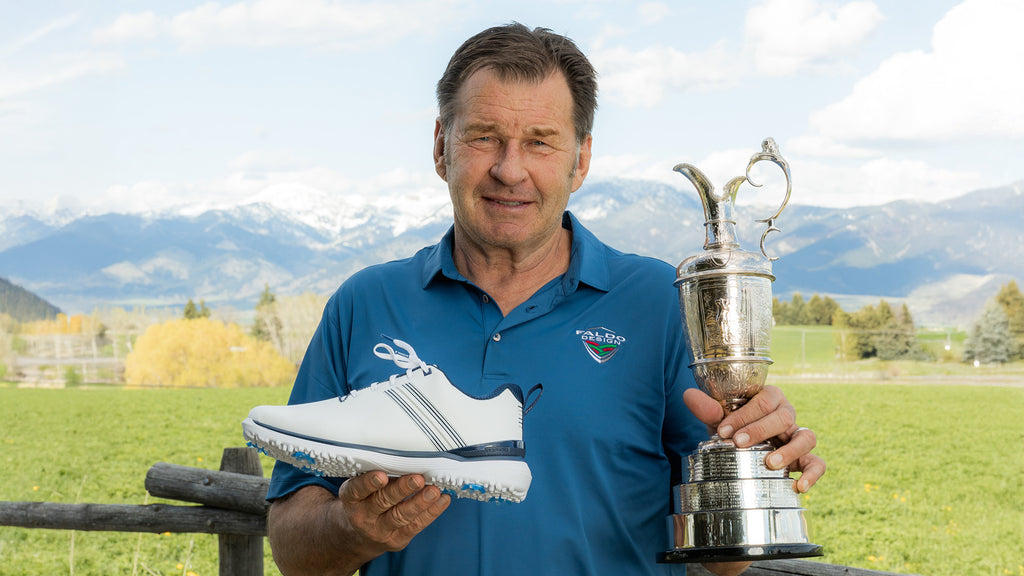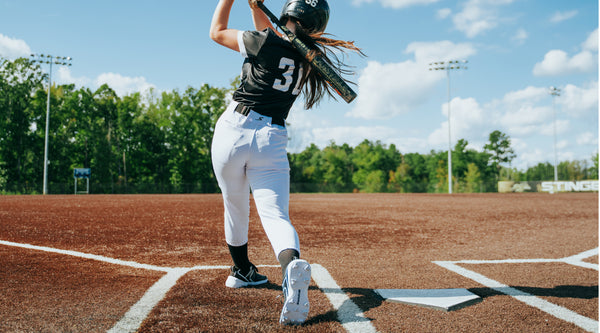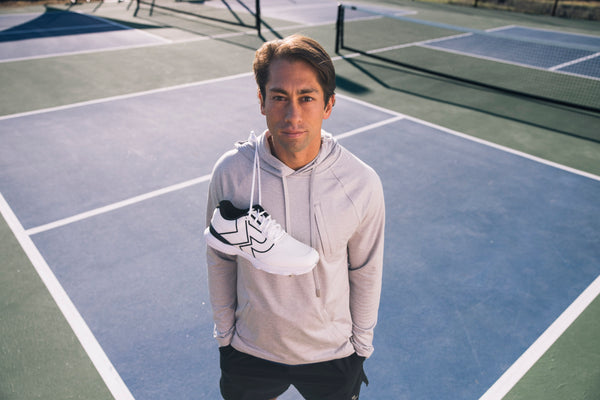Overview
On March 22, 2024, our team at SuperSpeed Golf decided to test one of the most common questions we see about equipment: Do golf shoes make a difference in speed production? We headed to Dr. Tyler Standifird’s Lab at Utah Valley University to go through a series of testing to see if we could get an answer. Tyler has some of the best equipment in the industry including Smart2Move 3D Force Plates, Trackman, and Qualisys Motion Capture. For our purposes on this day, most of the data came from the Smart2Move system. It is also important to note that we will be doing this testing indoors off of an artificial turf mat, although the data was collected while standing on the surface of the Smart2Move Force Plates.
Part 1 - Michael Napoleon Subject
We tested three different subjects during the day. This time, I was the first subject. We wanted to test someone who had a good understanding of how to use the ground to influence speed. I’m by no means a tour pro, but a PGA Professional with a relatively proficient game and above average understanding of how to use the ground during the golf swing. I’m about a 3 handicap and play regularly throughout the year. I’ve always been a player who uses more torque on the ground than vertical force and am constantly trying to increase vertical force production, especially on the lead side.
I’m going to hit some shots with three different golf shoes and see what the data shows. The first shoe is a FootJoy Flex Coastal Spikeless size 11 wide, which is the shoe I would use for a typical round of golf. I’m then going to test a minimalist, zero drop shoe made by a company called Whitin in size 11 wide. Finally, I am going to test the new Sqairz Velo golf shoe in size 11.
The FootJoy Flex, which we will use as a baseline for this testing is a very comfortable, soft golf shoe. It is spikeless, but has a significant amount of traction on the sole. The base of the shoe is made of foam and is certainly not rigid, allowing the shoe to move and twist with the motion of the foot. This shoe also has a standard insole that is about 3-4mm thick. This shoe provides no restriction of any kind with the motion of the ankle inside the shoe. The heel is raised slightly compared to the toe box in this shoe.

The second shoe we are testing is the Whitin minimalist zero drop running shoe. These shoes are very simple with a very thin insole of only about 2mm. The heel of the shoe is not raised at all compared to the toe box of the shoe, putting the foot in a position very similar to standing barefoot. The bottom of the shoe is made of rubber that has good grip. However, this surface is significantly smoother than the other shoes we are testing.


The final shoe we will test is the new SQAIRZ VELO. SQAIRZ describes this shoe on their website as “Golf’s first ever speed-rated shoe.” These shoes are designed for players who are trying to create maximum swing speed and aggressively trying to use the ground. In fact, we pulled the following quotes directly from the SQAIRZ Website about these shoes:
✔️ Engineered to impact your scorecard.
Initial testing shoes an average increase of 12 yards in distance, 3.9MPH in swing speed, and 30% in dispersion tightening.
✔️ Unparalleled ground force production.
AI-generated Smart Traction System with over 290 points of penetrating ground contact to create grip and power on any terrain.
These are definitely some strong claims. We are excited to see how our testing matches up to these claims. The shoe itself is an extremely stable golf shoe. The footbed is far more rigid than the other shoes we are testing. The spikes on the bottom and grip pattern is much more aggressive than the other shoes as well. The upper part of the shoe is slightly higher than the others, providing more stability for the ankle. The insole is similar to the one in the Footjoy being about 3-4mm thick. The shoe also feels like there is a little more arch support and a very wide toe box compared to the other shoes. In fact, I usually wear an 11 wide in most brands and the standard 11 fits perfectly in the SQAIRZ. I also feel that the area around the heel and arch of the foot is much more stable in the SQAIRZ while still allowing for more room in the toe box of the shoe than the other brands. Overall, this is a really stable golf shoe.

There are many things to look at when it comes to creating ground reaction forces and how this relates to speed. Typically every case is a little different and positive results vary a bit in presentation. In my case things are fairly simple, I am looking for an improvement in vertical force production, especially from the lead leg while maintaining or increasing the amount of torque I am producing. Before we get into the data, let’s define a few things to make sure we are all on the same page when it comes to ground reaction forces and the specific metrics we looked at on this day. These are some of the areas that we tend to see big correlations to speed production and efficient use of the ground.
Trail Leg Lateral Force - This is force that occurs when the golfer pushes away from the target with the trail foot. The associated GRF would then point towards the target, helping the player to create motion towards the target. We typically want to see this force equal to about 20% of the player’s body weight through the inside heel area of the trail foot, and peaking before transition.
Torque - This is created by a combination of the trail foot pushing away from the ball and the lead foot pushing toward the ball during the transition of the golf swing. The associated GRF would be away from the ball from the lead foot and towards the ball from the trail foot. Torque helps the player create fast rotational speed in the lower body. We typically want to see about 100 nm/mass or more.
Vertical Force - Vertical force is a ground force created by the player pushing down into the ground. This is typically the largest ground reaction force produced in the golf swing. We measure this force both as a combined force of both feet and on the lead leg alone. We like to see this peak early in the downswing. In elite players, we want to see about 200% of body weight combined and 140% of body weight on the lead side.
Impulse - Impulse is the calculation of total force produced over time. Some players will create a smaller peak in force, but apply this force over a greater amount of time. On the other hand, some players apply a tremendous amount of force in a very short amount of time. Impulse is extremely important when looking at how players with different swing styles use the ground effectively.
Let’s take a look at how these values compare on the swings we took in this testing. We will use the FootJoy shoe as a baseline.
|
Trail Leg Lateral Force (%BW) |
Lateral Peak |
Change |
Lateral Impulse (%BW*sec) |
Change |
|
FJ Flex (baseline) |
19 |
6.3 |
||
|
Zero Drop |
17 |
-11% |
6.9 |
10% |
|
SQAIRZ VELO |
20 |
5% |
7 |
11% |
|
Torque (Nm/kg) |
Torque Peak |
Change |
|
FJ Flex (baseline) |
100 |
|
|
Zero Drop |
96 |
-4% |
|
SQAIRZ VELO |
114 |
14% |
|
Vertical Force (%BW) |
Total Peak |
Change |
Lead Peak |
Change |
Lead Impulse (%BW*s) |
Change |
|
FJ Flex (baseline) |
158 |
111 |
72 |
|||
|
Zero Drop |
146 |
-8% |
114 |
3% |
80 |
11% |
|
SQAIRZ VELO |
159 |
1% |
116 |
5% |
105 |
46% |
Let’s look at some detail in the data in this case. First, one of my goals is always to create as much vertical force as possible with more coming for the lead side. This is something that I am constantly working on in my swing. We saw the biggest increase with the Sqairz Velo. On the surface a total vertical force gain of 1% is not a huge difference. When we look deeper, however, we see that the way I was applying that was significantly improved. First of all more was being produced on the lead side, 5% more than in the baseline. The huge difference in the lead side vertical impulse, which increased by an amazing 46% over the baseline. This comes from an earlier and longer production of vertical force from the lead side in the downswing and an earlier peak magnitude. We were not surprised to see that the combined peak went down a bit with the Zero Drop shoe. However, it is interesting to note that we were able to get a higher percentage on the lead side with this shoe, also resulting in slightly higher lead side impulse. It is very easy to feel the point of application in minimalist shoes. I believe this made it easier to improve the percentage of force between my trail and lead foot. It was certainly not as easy to produce big vertical forces in the Zero Drop than in the Sqairz. The overall stability of the SQAIRZ VELO provides a great platform for the production of vertical force.
FootJoy Lead Leg Vertical Peak (111) and Impulse (72)

Zero Drop Lead Leg Vertical Peak (114 +3%) and Impulse (80 +11%)
SQAIRZ Lead Leg Vertical Peak (116 +5%) and Impulse (105 +46%)
The next area that is important to note in this case deals with Torque. Torque has always been my primary power source when it comes to using the ground. I’m looking to get as much as possible in this category and saw a significant increase (14%) when wearing the SQAIRZ VELO. We need to do a lot more testing, but it seems that the amount and quality of the tread and spikes on the bottom of the shoe have the most impact on the production of Torque.
Torque Comparison:
FJ Flex (100 nm/mass)
Zero Drop (96 nm/mass -4%)
SQAIRZ VELO (114 nm/mass +14%)
Lateral force has not be a primary focus for me in the past. I have always produced a reasonable amount of lateral force and have other other areas to try and improve when it comes to ground reaction forces. That being said, a small gain here is certainly something I am fine with seeing.
The feel of the SQAIRZ VELO certainly makes it easy to load laterally into toward the heel of the trail foot. This seems to be a result of the stable base of the shoe and the specific placement of the spikes on the inside of the foot. The shoe has two spikes on the inside of the bottom near the heel and one spike on the outside. This makes that inside portion of the shoe feel more solid and allows the player to sink more toward the heel of the foot. The change in point of application most significantly in the SQAIRZ VELO and also to some extent in the Zero Drop shoe is a very significant change from the FootJoy. The FJ Flex does have a slightly higher heel which angles the foot forward slightly compared to the other shoes. This makes it much harder to create proper point of application. The below point of applications are all at lateral force peak.
FJ Flex
Zero Drop
SQAIRZ VELO
The amount of lateral force also increased with the SQAIRZ VELO.
FJ Flex Peak Lateral (19%, Impulse 6.3)
Zero Drop Peak Lateral (17% -11%, Impulse 6.9 +10%)
SQAIRZ VELO Peak Lateral (20% +5%, Impulse 7.0 +11%)
The lateral force production graphs are fairly similar between the shoes. We would posture that the increase in trail leg lateral impulse is mostly due to the improved point of application with the Sqairz and Zero Drop, leading to not only 5% bigger force, but also that force applied over a longer amount of time making the impulse 11% bigger.
So how did these significant changes in ground reaction forces affect speed? Here are the results from Trackman:
FJ Flex (Baseline)

Zero Drop
SQAIRZ VELO
These results were pretty shocking on the day. There weren’t any huge differences between the number for the FJ Flex and the Zero Drop. These are definitely within the margin of error of just being different shots. However, with the Sqairz, there were some significant changes.
|
Speed Data |
Club Speed |
Change |
Ball Speed |
Change |
Carry Distance |
Change % |
Change Yards |
|
FJ Flex (baseline) |
101.5 |
145.2 |
242.3 |
||||
|
Zero Drop |
102.1 |
1% |
145.7 |
0% |
241.5 |
0% |
-.8 |
|
Sqairz Velo |
105.7 |
4% |
152.3 |
5% |
259.2 |
7% |
+16.9 |
I gained 4% club speed, 5% ball speed, 7% carry distance at a whopping 16.9 yards. This exceeded the 3.5% and 12 yards of distance that Sqairz claims on their website. Obviously this is just one person, one day, but these are certainly significant enough results to make me put these shoes into play immediately.
Part 2 - Two Random Subjects
In this next segment of our testing, we are looking how amateur players will not only be affected by just changing from their own shoes to Sqairz, but also if using Sqairz during ground reaction force drills will affect the player’s capacity to create bigger increases in ground reaction force production. What we are going to do here is have each of these subjects hit some shots on the Smart2Move 3D Force Plates in their own shoes, then in Sqairz, then go through our Level 2 Ground Reaction Force Training Protocol from SuperSpeed Golf, and then retest the results in both their shoes and the Sqairz. We want to find out if Sqairz will help these players create bigger gains through training.
Let’s discuss a little about the two subjects we are going to work with today. The first, Marcus Krommenhoek is a very athletic player who played competitively in high school. He is now a pre-med student at Utah Valley University and plays about 1X a month or so. He described his game as strong off the tee and with distance and estimated about a 9 handicap. We certainly agreed with the power off the tee as soon as we saw some shots come through. He averaged in the mid-180s ball speed throughout the session. Our second subject, Truman Brown, had much more “normal” club speeds, and has been a recreational player for a long time. He’s also a pre-med student at Utah Valley University and plays infrequently at the current time. Truman is a 10 Handicap.
As we watched the initial data from both subjects we noticed a number of concerns with how they were using the ground which helped formulate the goals we would want to have for each of these players as we went through the training protocol. Marcus was certainly a high powered player and the ground reaction force numbers certainly supported that. His highest Vertical force in the pre-training data was 213 % of body weight and highest Torque was 179 nm/mass. Those are the types of numbers we see with world long drive participants. However, with all the swings we took pre-training, we saw that he would have inconsistency from swing to swing with either a very high Torque number or a very high Vertical Force number. We see this from time to time in players who have inconsistency with the timing of ground forces. In this case, we need to move the peak vertical force earlier in the sequence.
Our second Subject, Truman, was a much less complicated case of someone who needed more vertical force in the swing.
Truman’s shoes were a more flat bottom style casual golf shoe. Marcus’ were a Nike Jordan series shoe. Truman used the SPEED2 model from SQAIRZ and Marcus was wearing the VELO model.
Here is some of the baseline data we collected that connects directly to the above goals:
Subject 1 - Marcus
Variable Power Source and Late Vertical Force Peak
Baseline Swing 1 (Own Shoes)
Torque Peak - 166 nm/mass
Vertical Peak - 213%, very late
Baseline Swing 2 (Own Shoes)
Torque Peak - 179 nm/mass
Vertical Peak - 185%, even later
We saw Marcus create swings that had exceptionally high Vertical Force, however, on these swings he would have lower Torque and be late with the Vertical Force peak. We would then see him make a swing where he had exceptionally high Torque, but much less vertical force with an even later peak. Getting the Torque and Vertical Forces peaking earlier in the swing was certainly a need in this case.
We also made a swing with the SQAIRZ VELO before doing any drills. Here is what that swing looked like:
Pre-Training SQAIRZ
Torque Peak - 169 nm/mass
Vertical Peak - 188%, Slightly Late
There are a couple points that are very interesting to note in this swing. By just changing to the SQAIRZ shoe, we see the timing of Marcus’ vertical force peak move from nearly at impact to about shaft parallel on the downswing. Now this is still a little late, but significantly better than the previous swings. We also see a small increase in Torque over Baseline Swing 1, and small increase in Vertical Force over Baseline Swing 2. The important part is not the amount of these small increases, but that they were happening during the same swing.
Subject 2 - Truman
Needs an Increase in Vertical Force
Baseline Swing (Own Shoes)
Vertical Peak (combined) 172%
Lead Leg Vertical Peak - 129%, Impulse 104
Baseline Swing (SQAIRZ)
Vertical Peak (combined) 177%
Lead Leg Vertical Peak - 138%, Impulse 109
For Truman, it is important to note that we started to see improvements in vertical force production immediately after putting on the SQAIRZ VELO. Combined Vertical Force went up 3%, Lead Leg Vertical Force went up 7%, and Lead Leg Impulse went up 5%. Those are great gains considering these are all primary goals for this player. On a side note, Truman was producing 129 nm/mass of torque on his baseline swing with his own shoes. This also increased significantly to 139 nm/mass, a 8% gain when he put on the SQAIRZ.
Torque Pre-Own Shoes 128 nm/mass
Torque Pre - SQAIRZ 139 nm/mass (+10%)
The next step in this process involved the two subjects going through two cycles of our SuperSpeed Ground Force Level 2 Protocol. This protocol works on a number of different things including timing, point of application, and magnitude of ground reaction forces. This was a great protocol for both of these players. The details of the specific drills in the protocol are below:
Ground Force Level 2
|
Description |
|||
|
Golf Skater s |
1 |
8 |
Start with your feet together and jump laterally to the right. Land trying to keep the pressure on the inside of the foot toward the heel. You should feel your right glute activate during the landing process. Then in one motion explode to the left as far as possible. Reset and do 8 total reps. |
|
Step Back |
2 |
3 |
Start with the right foot moved toward the left. Counter-Rotate the swing forward and then step back with the right foot during the first part of the backswing. You felt “stronger load” into the right side during this drill. Make sure to keep the pressure on the inside and toward the heel of your right foot. Do one set of practice swings with a red superspeed club and one set of shots. |
|
Trail Foot FP Smash |
2 |
3 |
Place a large force pedal under the inside heel of your trail foot with about half of the force pedal exposed. You felt “stronger load” into the right side during this drill. Make sure to keep the pressure on the inside and toward the heel of your right foot. Do one set of practice swings with a red superspeed club and one set of shots. |
|
Step Chang e of Directi on |
2 |
3 |
Start with your feet together. Make swings stepping through the swing. Make sure when you land with the lead foot that you are pressing on the ball of the foot, down and toward the ball. Do one set of practice swings with a red superspeed club and one set of shots. |
|
Lead Ball FP Smash |
2 |
3 |
Place a small force pedal under the ball of the lead foot. Make swings with a small counter rotation using a firm push into the force pedal as the starting motion for the transition of the swing. During this drill make sure that your upper body doesn’t “lean” over your foot. Your lead foot should be pushing toward the ball aggressively which should make your hips and torso feel like they are moving away from the ball. Do one set of practice swings with a red superspeed club and one set of shots. |
|
Double Smash |
2 |
3 |
Place a large force pedal under the heel of the trail foot and a small force pedal under the ball of the lead foot. Smash the trail FP during the takeaway and backswing and the small one during the transition. Do one set of practice swings with a red superspeed club and one set of shots. |
|
Normal Stance Rocker Swings |
1 |
3 |
Repeat the above drill without the force pedals trying to replicate the feel. As you progress with the drill, try to make the forward and backward presses smaller, while still getting the same sensation of a counter rotation without a counter rotation. Do three shots in a row without any practice swings. |
The drill program took each player about twenty minutes to complete. After this time, we retested both players in the SQAIRZ and their own shoes.
Subject 1 - Marcus
Post Training Own Shoes
Torque - 190 nm/mass
Vertical Peak - 188%, Shaft above parallel
In his own shoes after the training protocol, we saw Marcus’ highest Torque production at 190 nm/mass. That is actually one of the highest torque values we have ever recorded. This is a 14% gain over baseline 1 and a 6% gain over the highest Torque we saw pre-training. This is a great result, however, we were still seeing less Vertical Force than we would like. 188% of body weight is certainly good, but it is still about 6% less than we would expect as a baseline for a player of this speed and underbalanced when the player is creating 90% more Torque than our typical bar. The timing of these forces, however, is greatly improved from before the training.
Post Training SQAIRZ
Torque - 183 nm/mass (+10 BL1, +2% BL2)
Earliest Timing Recorded
Vertical Peak - 215% (+1% BS1, +16% BL2)
Earliest Timing Recording
Marcus got the best results from wearing SQAIRZ post training. We finally were able to see him get the timing of both Torque and Vertical force peaking earlier in the swing. We’d still like these peaks to be a few frames earlier, but compared to the data pre-training, this change will make a world of difference. We started to see this in the data as well. This swing was the first time Marcus was really able to maintain his extremely high Torque (183 nm/mass in this swing) and create an extremely high Vertical Force (215% of body weight). We are very confident that for Marcus, working on his ground forces with our SuperSpeed Protocols will have a very positive effect on timing and magnitude. We are also confident that having him train and play in his new SQAIRZ shoes will give him the capacity for much higher gains than with his old shoes.
Subject 2 - Truman
Post Training - Own Shoes
Vertical Peak (combined) 183% (+6%)
Lead Leg Vertical Peak - 138% (+7%)
Impulse - 114 (+10%)
After the training protocol, we saw some good gains with Truman. He was able to increase Vertical Force production overall by 6% and had a 7% gain on the lead leg. There was also an impulse improvement of 10% on lead leg vertical force. These are significant changes and certainly show that the drill program will help Truman increase vertical force production.
Post Training - SQAIRZ
Vertical Peak (combined) 189% (+10%)
Lead Leg Vertical Peak - 141% (+9%)
Impulse - 131 (+26%)
The post training data for Truman again showed even more improvement while wearing SQAIRZ than with his own shoes. In this case by a significant amount. Truman gained 10% total vertical force, 9% on the lead side, and a huge overall vertical impulse gain of 26%. Wearing SQAIRZ while working on ground reaction forces with our SuperSpeed protocols has a definite benefit for Truman.
Here at SuperSpeed we will continue to test the SQAIRZ lineup of golf shoes in conjunction with our protocols. We love data and certainly need more than this initial testing to learn exactly how these shoes will affect different players. That being said, these results both for my swing and the swings and training of our two subjects were simply amazing. The results and overall feel of stability and control that I personally got when swinging in the SQAIRZ VELO were unlike anything I have felt before in a golf shoe. It is very exciting to see a golf shoe company embrace the science of speed production and create a shoe that makes using the ground easier. For our subjects, giving them a better shoe to train how to use the ground showed great promise and improvements in their efficiency. Both players commented multiple times about how much more stable the SQAIRZ felt. The added features on these shoes significantly increased the capacity for these players to improve their ground reaction forces. After this testing, we are certainly comfortable recommending giving SQAIRZ a try, especially if you are planning to try out our new SuperSpeed ground reaction force protocols.






1 comment
I’ve been very pleased with the comfort and stability of my Sqairz. I really have no reason to go back to another shoe.